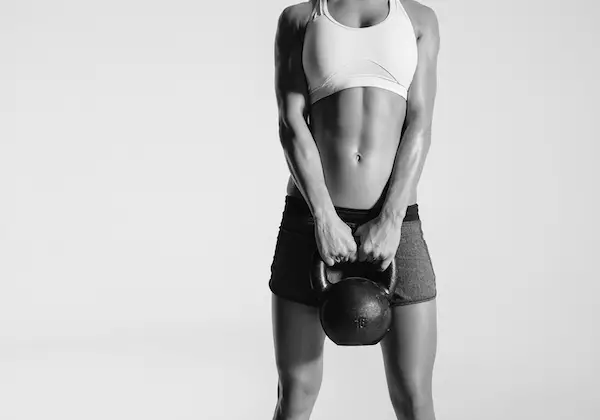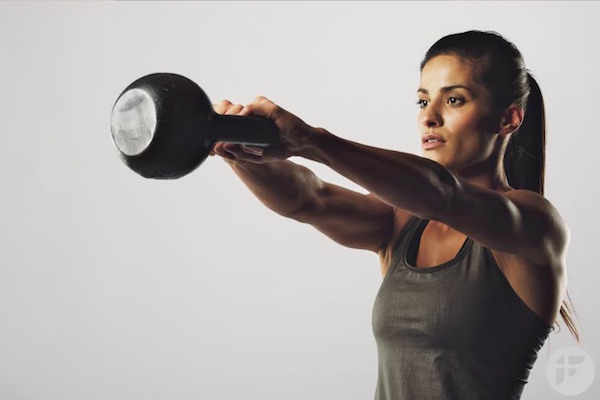So, you want to play with kettlebells? Well, you’ve come to the right place. Let’s assume you don’t know anything about kettlebells. In my experience, that’s most people’s reaction.
First, they ask “What’s a kettlebell?”
It’s a rock with a handle, making rocks much easier for humans to lift. Okay, that’s not the real definition, but close enough. These weights are comparable to dumbbells as most lifts use just one hand, you can double up, and they come in all different sizes making them accessible to people of any athletic ability.

Where to buy kettlebells
You might already have something lying around, but many kettlebells found in stores are very lightweight. While this isn’t a bad thing, it’s best to invest in one or two kettlebells; a challenging but manageable weight that translates well into any one-handed exercise, and a slightly heavier one for two-handed exercises (or for when you get stronger!)
A beginner should opt for a 12 or 14 kilogram (25-30 lbs) kettlebell. If you’re accustomed to lifting heavy weights, you can likely opt for a 16 kilogram (35 lbs.) kettlebell – a versatile option for men and women.
For a heavier weighted kettlebell, try a 24 kilogram (53 lbs.) weight. This will come in handy for full-body, two-handed exercises. Some of the most reputable brands of kettlebells come from Rogue Fitness, and they offer bells in all sizes.
If you’re on a tight budget or hesitant to make an investment as a kettlebell beginner, try an adjustable kettlebell.

The most unique aspect of working out with kettlebells is the conditioning. Besides strength and muscle development, you can break a serious sweat with the endurance exercises and cardio that are built into kettlebell circuits.
Finally, there are so many exercises to build upon and they are almost ALL considered full-body lifts. Some people like to work specific parts of the body, but for those of us hoping to increase overall strength, stamina and fat loss, the kettlebell is your best friend.
These are the five exercises you should start out with. Disclaimer: Some of these lifts (i.e. the Turkish get-up and the kettlebell snatch) are technical lifts which rely heavily on form and technique to avoid injury. Please consider proper training with someone who is RKC certified before attempting these at home.
Heavy kettlebell swings
Swings are the obvious choice when it comes to working out with kettlebells. They encompass all the important aspects of a full-body movement while burning some serious calories in a short span of time.
They increase both strength and endurance. While you can opt for lightweight one-handed swings or double-handed swings, alternating between arms is like killing two birds with one stone.
Choose a challenging weight that you can bring to chest-height for at least 10 reps in a row. You may be wondering, “How is this a full-body workout?”
While envisioning the movement in your head might lead you to believe that it’s all in the upper body, it doesn’t have much to do with your arms.
The kettlebell swing is an explosive movement. The drive comes from your feet being planted firmly on the ground, a slight bend in the knees, and a full hinge at the hips.
The hinge allows the weight to pull your arms back between your legs, and locking out your knees while pushing your hips forward brings the kettlebell back up. It should feel like a catapult, and the catapult is encouraged almost entirely by your lower body.
Remember this: your swing is not a squat. As much as the drive comes from your lower body, it’s important to keep your hips ABOVE your knees.
Oh, and let’s not forget the core. If you do enough swings, your abs will be burning the next day! It’s important for you to keep your shoulders back (so the weight doesn’t drag your arms down) and stabilising your back means stabilising your core.
Try this: Set a timer and do as many swings as possible. Try for ten minutes. Find your rhythm and go with it. You can do 10 swings at a time, take a 30 second rest, and start again.
Turkish get-ups with kettlebells
Having trouble mastering the pull-up? Here’s the exercise you’re probably not doing yet to make it happen. Women in particular have a lot of trouble harnessing upper body strength, and it’s only natural, but that doesn’t make it impossible.
The Turkish get-up isn’t exactly an intuitive movement like the kettlebell swing. In fact, it’s rather awkward. Beginning in fetal position, you’ll curl up next to your bell and grab it.
Then, you’ll slowly stretch out, moving the kettlebell into the air as you eventually come from the floor to an upright position. Finally, you have to reverse the movement.
The hardest part? Coordinating opposite movements between arms and legs. Once you get that down, you can begin to appreciate the slow and steady burn that you’ll get performing Turkish get-ups for reps.
The Turkish get-up might seem goofy when you first watch someone do it or do it yourself, but it works every muscle in your body. This is hardly an exaggeration.
If you do enough of these, you will see the gains you’re after, and your other exercises WILL improve. Upper body strength? On its way. Promise.
Try this: Start with a light weight. Seriously, don’t try to push it! Do 5 get-ups on one side and 5 get-ups on the other side to warm up for a high-intensity kettlebell workout.
Kettlebell snatches
This has potential to be the most loved or the most hated lift. If you can get it down pat, snatch for reps and get into the literal “swing” of things, you will feel so powerful doing a routine with kettlebell snatches.
Of all kettlebell movements, it’s probably the most demanding in terms of cardiovascular endurance and strength. Cardio and strength? It means you can skip the treadmill. A snatch circuit might be the answer to the call for a short and sweet workout that works.
The snatch requires mobility in the shoulders, the same hinge in the hips you want in your kettlebell swing, and the strength to keep the bell above your head because you do NOT want to drop a kettlebell on your noggin. With this in mind, don’t up your weight too quickly. Work with a bell you can snatch for reps.
Technique should not be sacrificed, and it could take awhile to get down. The tough part? When you’re coming up, it’s helpful to envision elbowing someone standing behind you.
Your arm shouldn’t come from the hiking position to a full lock-out above your head. Remember, this is a full body thing, not an arm workout! While this move definitely uses a bit more genuine upper body strength than the kettlebell swing does, most of the power is driven from the legs and hips.
A tight grip in addition to a momentous hike back will “float” the bell above your head.
Try this: Set a timer for 3 minutes and do as many snatches as possible. It doesn’t sound like a long time, but it will feel like a long time. Try doing 5-10 on one side before switching to the other side.
Goblet squats with kettlebells
Squats are the holy grail of bodyweight movement and barbell movement, but the goblet squat is often left in the dust. There’s no good reason for this, either. Many people’s squats suffer, whether it’s knees caving in or super tight hips.
Some people just can’t hit depth while others struggle with keeping a straight back. Oh, and then there’s dreaded “buttwink.” Moral of the story? Squat form is important, and it’s worth taking some time to perfect.
The goblet squat offers up some serious benefit that can increase hip mobility and help you take on more weight with your barbell squat without sacrificing form. The weight being in your centre, rather than on your back or above your head, will balance you as it weighs you down naturally.
This helps your body to intuitively sit back into your squat rather than lean out of it or move from side to side. At the bottom, you will get some nice momentum as you pop back up.
Moreover, the weight will keep you grounded. When aiming to hit depth – when the backs of your thighs touch the backs of your calves – we often find our heels pulling up off the ground or our shoulders slouching forward. If you’re working with a heavy load, you WILL lose your balance and you’ll risk injury. That’s a big no-no!
The goblet squat is easily one of the most functional exercises you can add into your routine, whether to stretch and warm up or to work for reps.
Finally, squats have this reputation where it’s ALL about the booty. Contrary to popular belief, a proper squat will work so much more than that; hamstrings, quads, and abs come into the mix because proper squat execution means your entire body is tight and tensed, forcing every muscle to do its part.
Try this: Warm up with squats, focusing on depth, at the heaviest weight you can go, or whatever weight kettlebell you have. Do 5-10 for a great dynamic stretch that will provide your hips and knees with the TLC they need to work.
The military press
Now, it’s time to get buff. Ladies (and gentlemen), lifting weight above your head is hard work. Therefore, lifting weight above your head is a pretty clear indicator that you’re going to get an awesome workout. With that said, you cannot ignore the military press. Bonus? You’ll also have to ‘clean’ the kettlebell. Watch the video!
This lift works the shoulders, muscles in your back and the arms. Once again, the abs come into play with this lift, too. You can do all the sit-ups you want (you probably don’t want to), but nothing works the core and keeps it strong quite like lifting weights.
You can strict press the kettlebell which is the military press, and this mostly means you won’t be using any power in your legs. If you want to go heavier, you can do a push press which means you’ll draw a bit of power from a slight bend in the knees, lifting the weight as you lock the knees out.
If you want to get really strong, go for the double press. Because twice the kettlebell means twice the fun.
Drive power from your feet, keep your back as straight as possible (don’t let the weight sway you to the side), and keep your stance narrow which helps you keep tense. Tension is a defining factor in the success of every lift.
Try this: Kettlebell presses can be done as you like, but it’s helpful to work them for heavier weight. Set a number goal you’d like to reach and go for it at a manageable number. Test your one-rep max as it will improve over time.
Do you work out with kettlebells? What’s your favourite lift and why? Tell us in the comments below.
Music, mountains, dogs, travel, food and friends.


Lol Apart from the Turkish get up I just gave these all a go and they are awesome. What a work out and what a sweat. But they are fun. You get into a Rhythm and just keep going. Luv them
Lisa, that’s awesome!! I’m so glad you got a good workout in. It’s so fun to find that rhythm and just bust out some moves… it’s almost like a dance haha! Good work, keep it up!
I do all of these except snatch … I no longer see the benefit of the snatch over swings.
I agree! You get a lot of the same benefit. My favourite lift is personally the snatch, but I just love the extra conditioning with the explosiveness and the movement itself.